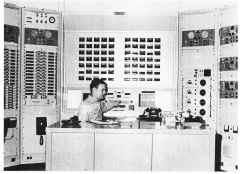| AN/FRD-10 Wullenweber Antenna Info
AN/FRD-10 antennas at Sugar Grove |
RF Patch Panel at Sugar Grove | |
Supervisor's Console at Sugar Grove |
This station has a switching matrix to switch receiver RF inputs to the individual elements of the Wullenweber antenna array or to the various beams and omnidirectional RF outputs derived from the Wullenweber. The supervisor's console incorporates control of this matrix and includes readouts from a sensing system within the matrix that show the signal levels of individual antennas. The console operator selects the antenna receiving the best signal. | |
The operational purpose of Navy Information Operations Command, Sugar Grove
is to perform communications research and development for the U.S. Navy, the
Department of Defense and various elements of the U.S. government.
The Navy’s presence in Sugar Grove began in 1955 when the present site of the
NIOC was selected for a Naval Research Laboratory (NRL) project which was to
lead to the construction of a large parabolic antenna for advanced
communications research. The site was selected as the ideal location for this
project because of the natural mountain shielding and the extremely low level of
man-made noise.
In 1956, a 60-foot antenna was completed and became operational for feasibility
studies for a 600-foot parabolic antenna. Originally, the site was developed as
a radio telescope that would probe outer space, tuning in on radio signals 38
billion light-years away from Earth. The 600-foot dish would have been the heart
of the operation. In 1958, ground was broken and construction began on base.
However, unforeseen advances in related fields of science and technology made
the project obsolete before it was completed and it was subsequently halted in
1962. The Navy abandoned the original intent of the project, but the 60-foot
dish is still operational today. It is referred to as the 1-10, as the dish was
to be one- tenth the size of the planned but never completed 600-foot antenna.
In 1962, in response to a request from Senator Robert C. Byrd (D-WV) to find
other uses for the Sugar Grove facility, the Navy proposed the site to be used
as a radio receiving station, due in part to its unique location within the
National Radio Quiet Zone. The zone, an area 100 miles square relatively free
from outside electromagnetic interference, was established in 1959 for the
nearby Green Bank Radio Observatory. Byrd noted that the natural isolation
provided by the George Washington National Forest and surrounding mountains made
for near-perfect conditions for high-frequency capability. The proposal for the
station was approved and in 1963, the Naval Radio Station (Receiver, NRS) was
established.
The original cost of the station at this site was $11 million. According to the
March 4, 1968 edition of the Congressional Record, its mission would be the main
receiver site for worldwide Navy Radio communications coming into the
Washington, D.C. area. Also in 1968, work was finished on the 150-foot parabolic
antenna, which is today the largest dish at the operations site. Further, the
Naval Security Group (NSG) established a detachment at the site in the same
year.
NRS Sugar Grove was formally commissioned on May 10, 1969. LCDR F.M. Tettlebach
was the first Officer-in-Charge of the new station. Navy personnel resided in
Cheltenham, Maryland, until the support site was completed. The Naval Radio
Station was called “The Navy’s Ear,” gathering communications from Navy
planes, ships and stations from around the world. Two huge, circular antenna
arrays, or Wullenwebers, each 1,000 feet in diameter, once served as the
station’s main receiving antennas.
In 1973, operational and administrative control of NRS was transferred to Naval
Communication Station, Norfolk. NRS became a component of Naval Communications
Area Master Station Atlantic, Norfolk and the Officer-in-Charge billet was
upgraded to Commanding Officer. The installation was awarded the Meritorious
Unit Commendation in April 1974, for outstanding support of the national
intelligence effort. Two years later, the 60-foot antenna operations were moved
to a new Naval Security Group operations building. Facilities work to the
previously unused lower level of the Underground Building (UGB) a year later
offered space to house the Naval Security Group Detachment’s communications,
administration, maintenance and logistics and operations groups.
The TIMBERLINE II project in 1984 provided additional opportunities to remote
systems to the 30-year-old UGB and provided needed upgrades to emergency power
and air-conditioning systems. The former NSG operations building, the Linn
Operations Center (LOC), is now home to the Supply and Training offices. The
building was dedicated to the memory of Chief Communications Technician Raymond
E. Linn, who gave his life in defense of his country aboard the USS LIBERTY (AGTR
5) in the Mediterranean Sea off the coast of Israel June 8, 1967.
Due to increased automation in Naval communications, in 1992 the mission of NRS
was merged with another location. On October 1, 1992, the Naval Radio Station
was officially closed and the Naval Security Group Activity was established. On
December 29, 2005, Navy Security Group Activity Command was also disestablished
for the same reason. Navy Information Operations Command, Sugar Grove was
established as part of the integration of NAVSECGRU functions into Naval Network
Warfare Command. The SECGRU Service Cryptologic element responsibilities have
been performed by the Information Operations Directorate of NETWARCOM ever
since.